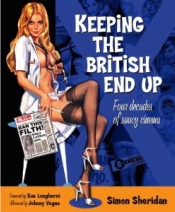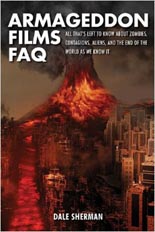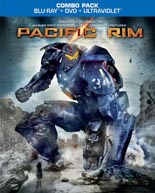
 There’s something you should know about Simon Sheridan’s Keeping the British End Up: Four Decades of Saucy Cinema: It stinks. But only literally. I don’t know what paper stock Titan Books used for this hardcover, but it carries the waft of B.O., crossed with perhaps a hint of eau de post-coital, so maybe it’s appropriate.
There’s something you should know about Simon Sheridan’s Keeping the British End Up: Four Decades of Saucy Cinema: It stinks. But only literally. I don’t know what paper stock Titan Books used for this hardcover, but it carries the waft of B.O., crossed with perhaps a hint of eau de post-coital, so maybe it’s appropriate.
Anyway, what matters is whether the contents are worth reading, no matter how obnoxious the scent, and that is a resounding “why yes, guv’nor!” In chronicling the history of the UK “slap-and-tickle” subgenre, Sheridan whips up a big bundle of fun. The book originally saw release a decade ago, but this recent new edition has been, according to the copyright page, “completely revised.”
Ask Sheridan in his introduction, does risqué equal sexy? Answers the remaining 300 or so pages, again, “why yes, guv’nor!” As was in America, the floodgates to depicted sex onscreen — we’re not talking hardcore porn here, it should be noted — opened only after the dawn of the “educational” health film and the “nudie cuties” that gave Russ Meyer and Herschell Gordon Lewis their starts.
Once Agneta Ekmanner gave moviegoers their first glimpse of pubic hair, in 1968’s Hugs & Kisses, there was no looking back, especially in the UK, where for a solid quarter of a century, the sex film saved cinema from the threat of television. In other words, the raunchy comedies were the CGI-laden superhero adventures of their era, making bona fide stars of physically gifted gals like Fiona Richmond and Mary Millington (an actual prostitute).
The bulk of the book is comprised of a chronological look of sex flick to sex flick, not just with lively plot summaries, but candid, behind-the-scenes bits from those involved on either side of the camera. It matters not if you’ve seen none of these movies, because Sheridan makes it entertaining reading; I haven’t seen a single one, but I came away with more than few for which to look out.
At the end, as the sex film moves from theaters to home living rooms via VHS, where they can be better — ahem! — appreciated, Sheridan includes brief bios of some of the subgenre’s superstars. Whether or not they’re covered in that section, it is interesting to note how many of the players are known to those shores: You have not only actresses like Joan Collins and Ava Cadell (an Andy Sidaris mainstay), but legit mainstream directors at various stages of their careers, including Jack Arnold (The Creature from the Black Lagoon), Michael Winner (Death Wish) and perhaps most notably, Martin Campbell (Green Lantern).
None of this would amount to anything if Keeping the British End Up were just text. It’s lavishly illustrated with stills and poster art throughout. While there’s a color insert, it’d be nice to see all of the art not in black and white, but just be glad it survives and that, hey, boobs aplenty. Keep it away from the kids, and close to your never-ending to-watch list. —Rod Lott





